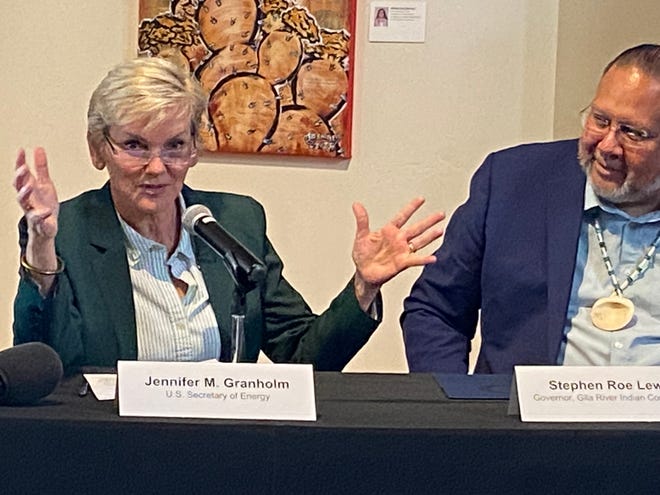Energy Secretary Granholm announces funding for tribal power generation, delivery in Arizona

U.S. Energy Secretary Jennifer Granholm met with Arizona tribes on Tuesday in Phoenix to hear their concerns and announce funding for several of the tribes to modernize and harden electric grids, build or expand renewable energy projects, including microgrids, and reduce power outages.
She also heard tribal concerns about electric supplies, weatherizing homes for energy efficiency and failing infrastructure in tribal lands.
Speaking at the Heard Museum, Granholm said the Navajo Nation was one of two tribes selected for the first round of funding for grid resilience formula grants from the Bipartisan Infrastructure Law. The grants, which totaled $50 million for the tribes and to four states, will fund electric grid modernization to reduce impacts due to extreme weather and natural disasters.
The Navajo Nation received $21.8 million to harden power lines, facilities and substations as well as upgrade equipment like transformers and bucket trucks.
Granholm also announced $9.3 million in a total of $34 million in grants to build clean energy projects in 18 tribal communities, including two in Arizona and one on the Navajo Nation’s eastern lands in New Mexico.
The Hopi Utilities Commission will use its $3.6 million grant to build a remote microgrid to power four water pumps to supply the villages of Upper and Lower Moenkopi. The microgrid will supply 400 kilowatts of electricity from a solar panel array, 1,500 kilowatt-hours of battery storage and a microgrid controller. The microgrid will save the tribe about $270,000 per year and $6.75 million over the system’s life, according to a statement.
With a $4 million grant, the San Carlos Apache Tribe will build a microgrid to supplement diesel generators at the San Carlos Apache Healthcare Corporation east of Peridot. The 750 kilowatts of solar panel-generated electricity and 500 kilowatt-hour battery storage system will serve 36 homes for health care workers and five hospital buildings.
Victoria Began, the health care corporation’s CEO, said the project would not only ensure uninterrupted operations during storm conditions but will protect sensitive equipment.
“We would see a storm coming and had to turn off the electronics,” she said.
The San Carlos Apache Tribe’s general manager, Christabelle Mull, said this and other projects support the tribe’s three energy goals: resilience, security and independence.
The Ojo Encino Chapter of the Navajo Nation will receive $1.7 million to install 50 solar power systems tied to the local grid to provide 250 kilowatts to homes in the eastern reach of the tribe’s lands in New Mexico. The project will offset up to 95% of the chapter residents’ electric bills and save those families some $2 million over the life of the system.
Navajo Nation President Buu Nygren said the supplemental electric service would greatly benefit residents in the chapter, some of whom were faced with $300 electric bills on monthly incomes of just $800.
“I’m happy there is money out there to support these programs,” he said. “Anything to reduce the cost of energy is important.”
Gila River Indian Community Gov. Stephen Roe Lewis thanked the Biden administration for supporting his tribe’s own energy projects, such as placing solar panels over irrigation canals to both reduce evaporation and generate electricity. He said he appreciated the all-of-government approach to addressing energy demands and water issues during the Southwest’s most severe drought in 1,200 years.
White Mountain Apache Tribe Vice Chairman Jerome Kasey said some homes in his eastern Arizona lands have meters that are so old and dilapidated that the electric company could no longer provide services. Pascua Yaqui Councilwoman Herminia Frias said some homes in her community were paying the same for electricity even after installing solar panels because they lacked weatherization to make them more energy efficient.
Brian Fickett, general manager of Tohono O’odham Utility Authority, said the 28,000-member tribe in southern Arizona needs better infrastructure.
“If one pole goes down, lots of people lose power,” he said.
And, Fickett said, Tohono O’odham sits at the “end of the line” on the electric grid.
“When California cuts power, we lose power.”
